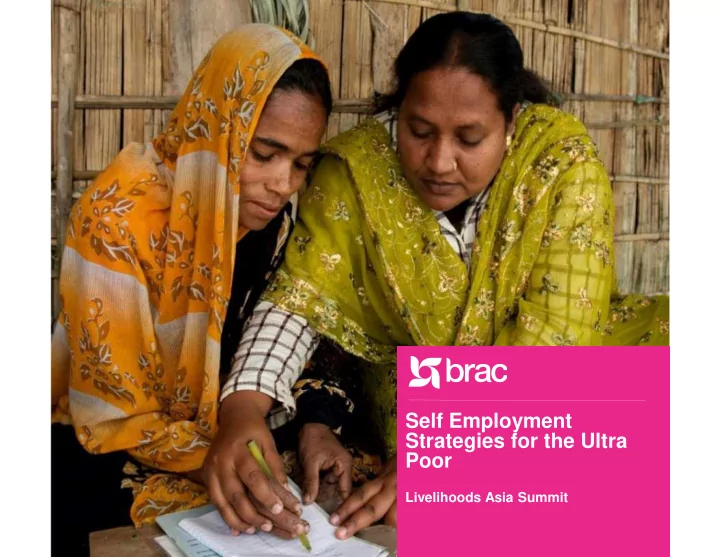

Self Employment Strategies for the Ultra Poor Livelihoods Asia Summit
What is BRAC? BRAC is a development success story spreading anti-poverty solutions across Asia, Africa and the Caribbean. Begun as a limited relief effort for refugees displaced after the 1972 Bangladesh liberation war, BRAC led by founder Sir Fazle Hasan Abed, developed a metrics-based approach to pilot and perfect programs before scaling them to reach millions. Countries where we work: Bangladesh, Philippines, Myanmar, Nepal, Afghanistan, Pakistan, South Sudan, Uganda, Tanzania, Sierra Leone, Liberia, and Haiti.
What is the Graduation Program? In 2002, BRAC pioneered the TUP program in Bangladesh to improve the resilience of the ultra poor and effectively address the worst forms of poverty. Since then, enrolling 100,000 new participants each year, BRAC has scaled the Graduation approach, as it is now known, graduating 1.7 million households (6.8 million people) with a projected reach of 2 million households by 2020 . BRAC TUP pilots have been conducted in Afghanistan, Pakistan, Sri Lanka, and South Sudan, and will expand to Uganda and Tanzania.
Who are the Ultra Poor? The World Bank estimates 902 million $1.90/day people live in extreme poverty (2015). The ultra poor are the poorest subset of the extreme poor, living on significantly less than $1.90/day. MULTI-DIMENSIONAL CONSTRAINTS FACING THE ULTRA POOR Live in geographically isolated, hard- Live in geographically isolated, hard- Chronically food insecure , eating less Chronically food insecure , eating less to-reach areas to-reach areas than 1,800 calories where the minimum is than 1,800 calories where the minimum is 2,000-2,500 based on gender, despite 2,000-2,500 based on gender, despite Underserved by markets and unaffected Underserved by markets and unaffected spending 80% or more income on food spending 80% or more income on food by economic policies by economic policies Disconnected from mainstream Disconnected from mainstream Lack community acceptance , Lack community acceptance , government services – such as school government services – such as school confidence, support systems confidence, support systems feeding and public works programs feeding and public works programs Predominantly a female-headed Predominantly a female-headed Most vulnerable to health shocks and Most vulnerable to health shocks and household in community with restrictive household in community with restrictive natural disasters natural disasters social norms social norms
Graduation Components
Step 01 Targeting BRAC relies on a triangulated targeting approach, including a participatory wealth ranking exercise, poverty mapping, and household surveys.
STEP 02 Asset Transfer for Income Generation & Livelihoods Following an in depth market analysis, participants work with their coach to select an enterprise for which they receive a package of assets such as cows, goats, chickens, etc.
STEP 03 Consumption Stipend To allow the client breathing room and time to start earning income from her assets, she receives a consumption stipend and in some cases a food item to supplement her diet.
STEP 04 Savings As food consumption stabilizes, clients are encouraged to begin saving, even if only in small increments, either semi-formally through self-help groups or formally with a financial institution.
STEP 05 Technical Skills Training Upon selecting her enterprise, each client receives technical training in how to care for her asset and generate income from running her business.
STEP 06 Life-Skills Coaching Regular visits from a coach provide clients with ongoing training, consistent progress monitoring and support, as well as vital self-confidence to succeed.
STEP 07 Healthcare Coaches act as the first line of defense in identifying potential health needs and connecting clients to available resources.
STEP 08 Social Integration Clients increase their social standing and receive guidance on integrating better with their community. Here, a village poverty reduction committee, organized by BRAC, conducts a regular monthly meeting, after clients have graduated, to help clients address various issues they face.
Graduation Criteria Graduation occurs when At least 3 sources of income ; households achieve economic and Asset value doubled since initial social advancement over the transfer; course of 24 months. Household consumes nutritional meals at least twice/day with protein (meat/fish/egg) at least once/week; Participant engaged in household decision-making (e.g. asset purchase); Improvement in home condition (e.g. corrugated roofs ); Attends social or community events ; and Access to sanitary latrine and clean drinking water Where applicable: School aged children attend school ; No under-age marriages ; and Use of family planning .
In Bangladesh , roughly 95% of participants achieve graduation at the end of the two year period with the 1.7 MILLION HOUSEHOLDS majority maintaining those improved conditions 7+ years later. AS OF 2016 International pilots by CGAP and the Ford Foundation demonstrate similarly high graduation rates for participants meeting country specific criteria.
Impact on Self-Employment Key Research Conclusions and Implications Significant increases in work productivity and household assets. 37% increase in annual earning. 361% increase in hours devoted to more stable, productive work Access to more stable and secure employment leading to positive expansion of occupation choice Reduction in economic inequality vis à vis the non poor Builds resilience and enables faster recovery from shocks Promotes social cohesion and gender empowerment For the bottom-most on the economic spectrum, a When viewed from a long-term ‘big push’ intervention is required. This needs to be a perspective, costs are not high value kick and over a long enough term to necessarily prohibitive if generate sustainable change impacts grow and are sustainable. 7 years later, ultra poor continue to escape poverty at a steady rate.
Join us in the movement to end ultra poverty. Visit www.ultrapoorgraduation.com . Contact ultrapoorgraduation@bracusa.org BRAC USA 110 William Street, 29 th Floor New York, NY 10038 USA
Recommend
More recommend